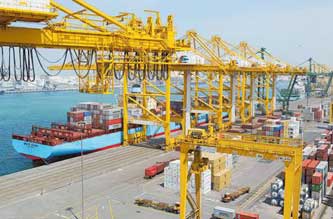|
|
UAE Freezones Biz News Updates
|
|
|
UAE poised to record large external surpluses in 2014-15
 Jebel Ali
port. Non-oil exports is likely to provide some underlying strength thanks to
healthy demand from Asia, the UAE’s main destination for goods trade.
Country’s foreign trade surplus reached a new high last year
The UAE posted a current-account surplus of $65 billion (Dh239.07 billion)
in 2013, and should maintain large surpluses over the next two years thanks
to elevated global oil prices, said Bryan Plamondon, Senior Economist, IHS
Economics.
Country’s current-account surplus held strong at $64.7 billion (16 per cent
of GDP) in 2013, following an upwardly revised surplus of $69 billion (18
per cent of GDP) in 2012.
The foreign trade surplus reached a new high last year, as elevated oil
prices, higher output, and strengthening external demand helped drive 8.3
per cent growth in exports.
“IHS expects slimmer, but still large external surpluses for the UAE in 2014
and 2015. We project the current account to edge down to a surplus of $50.8
billion (12 per cent) in 2014, as the trade surplus drops to $127.1 billion
under our baseline oil-price assumption of $109/barrel,” said Plamondon.
Merchandise exports are seen posting moderate growth of 6.3 per cent in
2014, to $402.5 billion, reflecting the constrained oil-export earnings.
Non-oil exports should provide some underlying strength thanks to healthy
demand from Asia, the UAE’s main destination for goods trade. Additionally,
UAE re-exports, which weakened because of Western sanctions imposed on Iran,
which previously had accounted for about 20 per cent of UAE re-exports,
could see some lift given the six-month interim accord between Iran and the
P5+1 countries.
Before sanctions, Dubai, which is the UAE’s trading hub and accounts for
three-quarters of total re-exports, had strong trade and business links with
Iran, but these shrunk considerably with traders and businesses coming under
greater pressure and constraints in dealings with the Islamic Republic,
especially regarding trade financing.
“Strong domestic demand is expected to fuel import growth of 14 per cent in
2014, with the import bill rising to $275.4 billion. Meanwhile, tourism and
hospitality services should see further growth in 2014 and remain supportive
to the UAE’s current-account balance,” said Plamondon.
If oil prices were to average $100/barrel in 2014, the current-account
surplus would narrow to $43.7 billion (10 per cent of GDP) this year. In
contrast, if oil prices average $120/barrel, the current-account surplus
would rise to $58.9 billion (13 per cent of GDP) in 2014. IHS economist sees
greater upside risk to the oil-price forecast now with the instability and
violence in Iraq.
The International Monetary Fund which concluded the Article IV Consultaion
recently said the macroeconomic outlook of the UAE is positive with economic
growth expected to remain strong at about 4.75 per cent in 2014 and 4.5 per
cent in coming years. Growth will likely be driven by the non-hydrocarbon
economy, which is expected to grow at around 5.5 per cent this year and
beyond.
The IMF sees external downside risks decline in oil prices, which could be
triggered by deceleration of global demand or coming-on-stream of excess
global supply capacity. The UAE’s substantial foreign assets and fiscal
surplus provide buffers against moderate or short-lived shocks.
June 20, 2014 |
| |
Courtesy Al Nisr Publishing LLC
|
|

